What is the Residential Demand Charge?
Watch this short video to learn what the Residential Demand Charge is and how it's calculated.
As a consumer-owned not-for-profit utility, Benton PUD exists solely to operate in the best interest of our customers. And we know affordable, reliable, and environmentally responsible electricity is critical to your health, safety, and well-being.
In addition to ‘keeping the lights on,’ it is our job to be forward-thinking and to anticipate and plan for increases to our costs, which are your costs. With some of the most aggressive clean energy laws and regulations in the nation, including the Clean Energy Transformation Act (CETA) and Climate Commitment Act (CCA), Washington State’s unprecedented regulation of electric utilities is beginning to put a premium on the cost of supplying electricity during the hours of the day when customer demand is the highest. Think early morning and late evening during winter cold and early evening during summer heat.
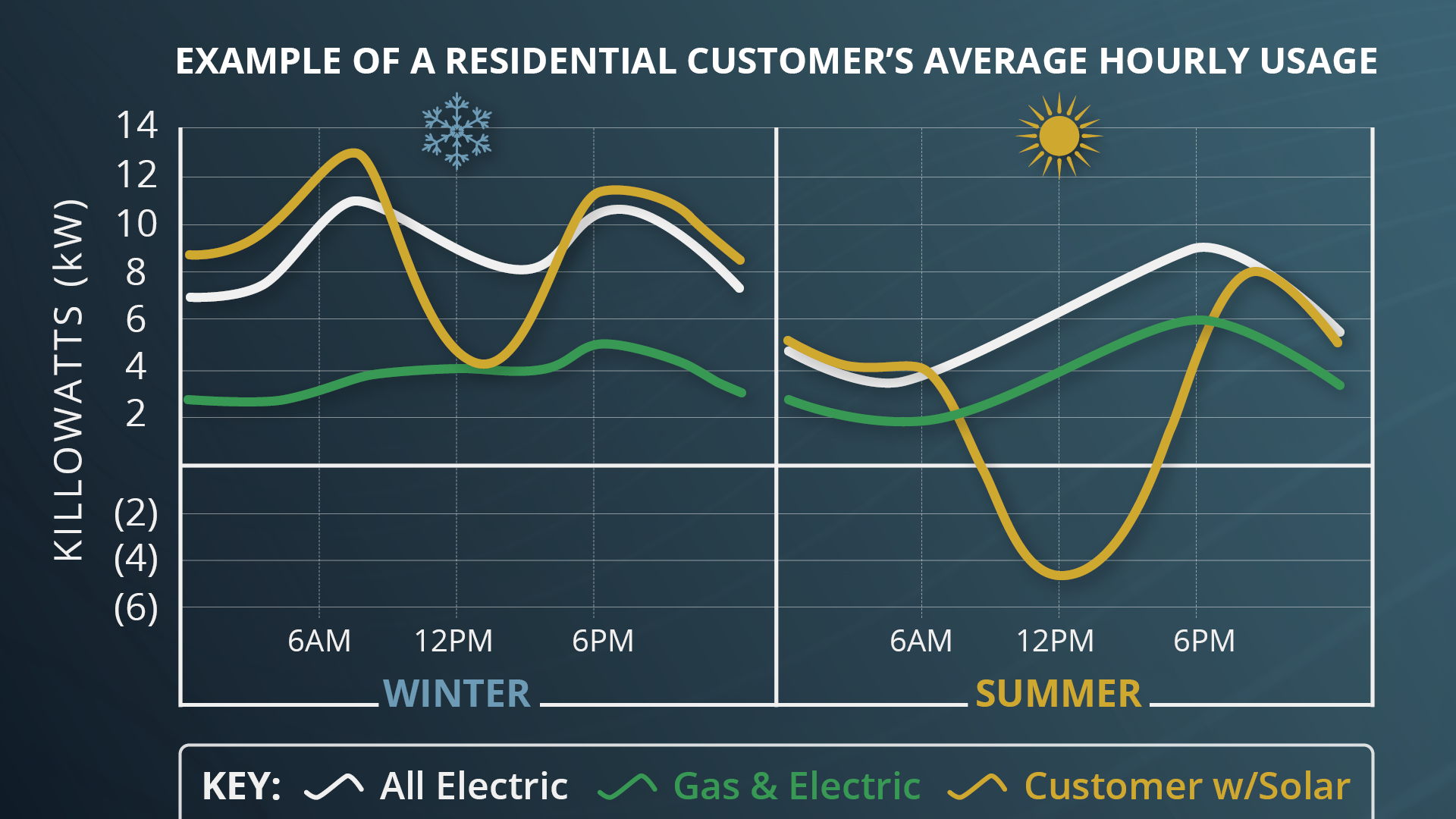
We know energy policies can be confusing and politically polarizing, but the simple fact is that electricity is a just-in-time service where the unforgiving laws of power grid physics requires the supply of electricity to precisely match demand on a minute-by-minute basis. While we are just beginning to experience increasing cost pressure during high customer demand periods, we anticipate this pressure will grow over time as utilities are forced to rapidly replace controllable, dependable, and affordable technologies with intermittent and variable wind and solar to satisfy CETA’s 100% non-greenhouse-gas emitting electricity requirements.
While it is true, with the help of generous tax subsidies, the costs for individual wind and solar farms have gone down in recent years, their inability to produce electricity in a controllable pattern matching customer demand comes at a high net cost due to the need to overbuild these technologies. Overbuilding means you must pay for multiple wind and solar farms to increase the probability that the total actual generated electricity derived from the sun and wind will be enough to meet customer demand across a wide range of weather and temperature conditions. But wind and solar are far from a perfect replacement of dependable technologies which means backup technologies must be in place and paid for, even if they only run part of the time. While energy storage technologies like batteries are beginning to be installed, they have serious operational limits. And no matter what form it comes in, energy storage will add significant costs to electricity due to the very large scale and redundancy needed to make a difference in power grid reliability.
While CETA’s 100% non-emitting electricity generation requirement by 2045 may seem like a far-off date, the effects of CETA’s post 2025 prohibition on coal-fired baseload generation and punitive financial penalties for using natural gas generation beginning in 2030 are impacting electric utilities like Benton PUD today. Additionally, the CCA has already added significant costs to the wholesale electricity market during high demand periods by adding a carbon tax to the cost of controllable natural-gas-fired generation needed currently for balancing electricity supply and demand on the hottest and coldest days of the year.
The bottom line is the costs of backup technologies, plus the costs of wind and solar overbuilds and the batteries they need to overcome their inherent operational deficiencies will increase the cost for utilities to maintain power grid reliability. And these increased utility costs are well established, particularly in states like California where some residential retail electricity prices are more than four times higher than what Benton PUD’s customers currently pay.
Fortunately, Benton PUD’s over 90% non-emitting, affordable and reliable hydro and nuclear wholesale power supply portfolio is helping keep our prices in check for now. But hydroelectric dams can only do so much. And while they too are a controllable source of electricity, they also represent variable generating technology with electricity output dependent on available water in the rivers, which can vary significantly from year-to-year and month-to-month. Additionally, in attempts to improve salmon runs, the generating capability of hydroelectric dams has been reduced significantly over the years by routing unprecedented amounts of water through spillways rather than through turbine-generators. And calls for even more ‘spill’ continue to be a part of ongoing litigation related to dam operations which could further diminish the amount and flexibility of hydropower in the future.
So how is Benton PUD responding to the increasing cost of grid reliability? First, we started by requesting a change to our wholesale electricity supply contract which was approved for implementation by the Bonneville Power Administration beginning October 1 of this year. This contract change gets Benton PUD out of the business of transacting directly in wholesale electricity markets which are becoming more volatile and uncertain in terms of price and availability of dependable generating supplies. Second, we are implementing a change to our residential rate design to send a small price signal incentivizing customers to consider shifting some of their electricity use to hours other than those corresponding to periods of maximum power grid demand. This type of charge for demand has been in place with Benton PUD’s commercial, industrial, and large irrigation customers for most of our 77-year history, so it is not a new concept. And while some costs of regional power grid generation and transmission has been included in longstanding demand charges, historically the biggest cost drivers were utility investments in equipment and wires required to avoid overloading local community electric delivery systems during high customer usage periods.
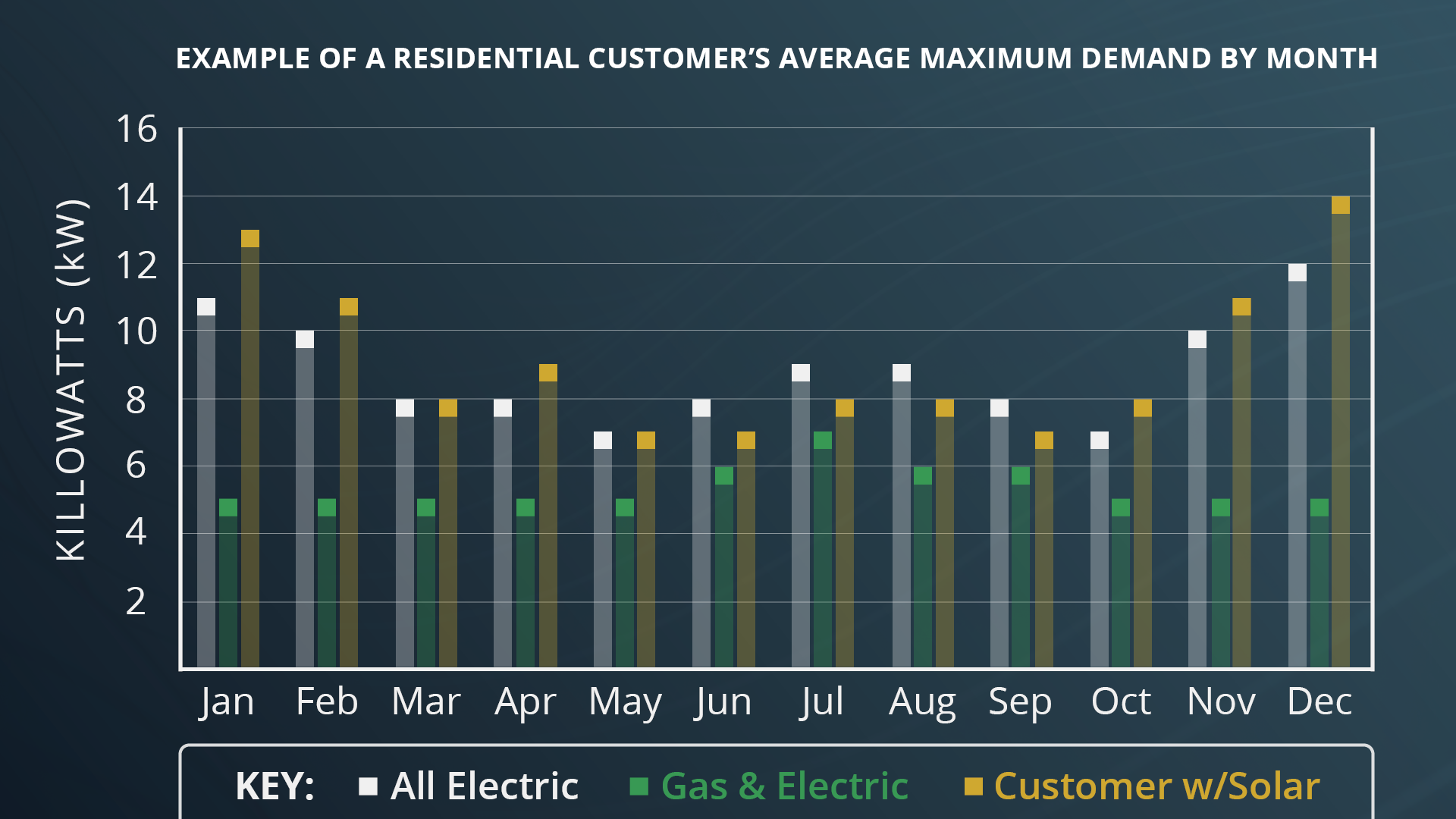
Maybe you’ve never thought of it before, but electricity demand on the power grid reflects the rhythm of modern human life. Tracing out a curve with a generally predictable shape and maximums at points in time when people are awake and simultaneously using the most electricity: making hot water, heating or cooling the house, getting ready for work, preparing meals, doing laundry, charging your electric vehicle, etc. This means that at certain times of the day, people are collectively using more electricity than other times creating a higher demand on the electrical grid, which we have established requires controllable and dependable generating technology to respond.
Our goal is to keep rates as low as possible and we want to work with our customers to achieve that. Through investments we have made in Advanced Metering Infrastructure, we are in a position to improve our residential retail rate design and to give our customers the ability to choose to change their electricity usage to lower costs or decide to pay a small premium when using electricity during peak periods. Starting in November, residential customer bills will incorporate a demand charge. The demand charge will be based on a customer’s highest one-hour of usage in peak periods and be $1/kilowatt. To make this change in a manner that does not result in overall increased revenues for Benton PUD, our residential energy rate, which represents the majority of a customer’s bill will decrease from 7.39¢/kWh to 6.88¢/kWh. The change will charge customers that have higher usage during peak hours a premium, and provide an opportunity for customers to lower their bill by decreasing usage during peak hours.
While this may sound complicated, it really is as simple as managing how many appliances and what electrical equipment is being used at once. Spreading out the use of appliances and equipment during peak periods lowers a customer’s demand, resulting in a lower demand charge. Benton PUD provides an online portal, SmartHub®, where you can view and monitor your usage; identify trends of when your peak demand is occurring; and determine how you may modify future electricity usage patterns if desired.
For the vast majority of customers, the new rate structure will result in a change to the monthly bill of $5 or less on average, either as a reduction or an increase. And it sets the framework for a more fair and appropriate collection of revenues that better aligns with Benton PUD’s costs. Benton PUD has a longstanding tradition of forward-thinking. Looking ahead, the implementation of a residential demand charge is a small incremental change to put in place, so our customers have as much control as possible in determining how much they pay for electricity on our way to meeting the state’s requirement to be 100% carbon free by 2045.
The demand read is based on the highest one-hour of usage during peak hours. Since the demand read is based on a one-hour measurement period, this represents how many kilowatts (kW) of demand were required for that hour (rounded to the nearest whole number). Only one demand read during a billing period will be used to calculate the monthly demand charge. For example, a customer has a billing period from November 8 through December 8 and their highest demand read during the peak hours was 5 kW and was set on November 18th between 7:00 p.m. and 8:00 p.m. The next bill they receive will include a demand charge of $5.
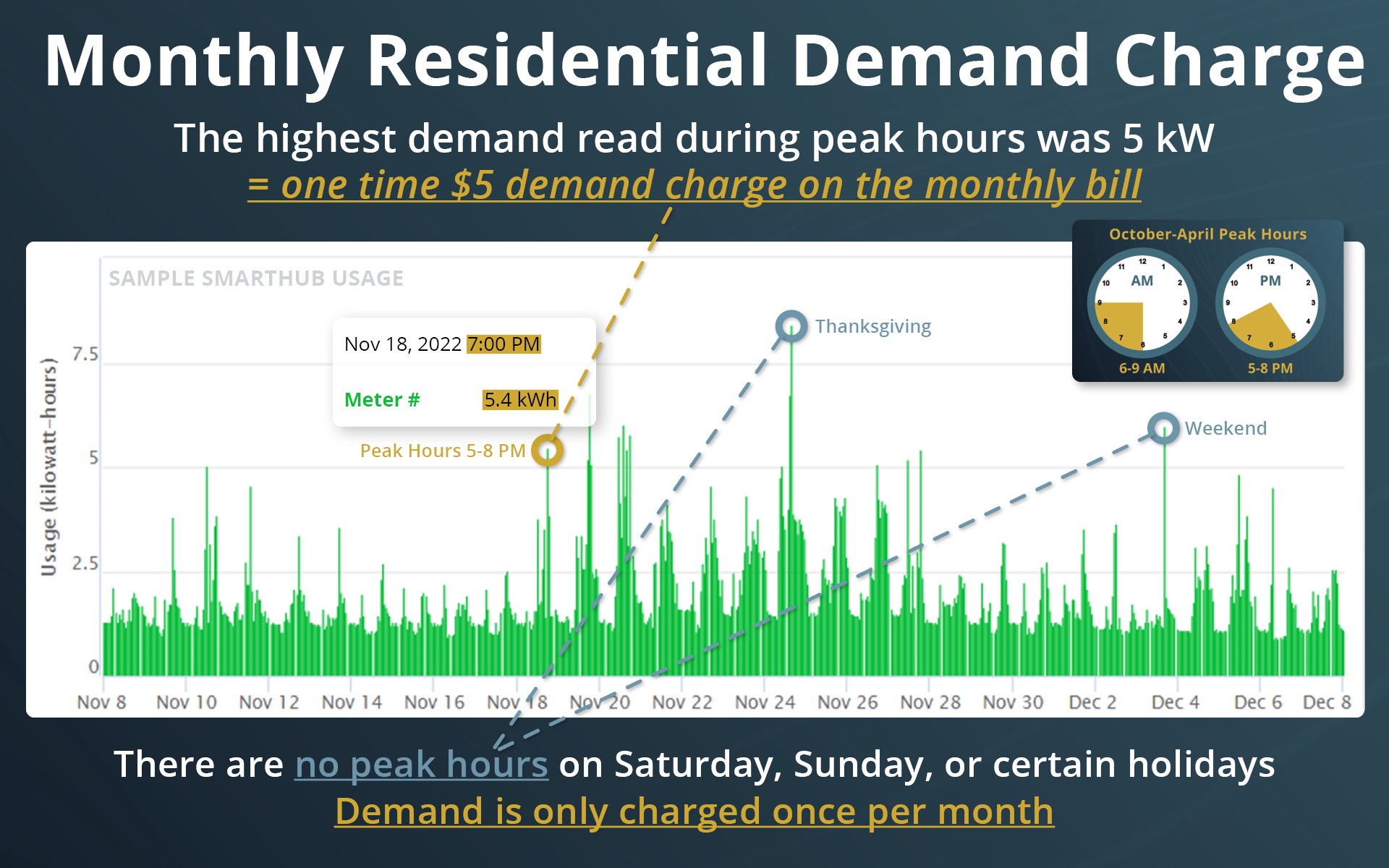
Demand (measured in kilowatts or kW) measures the rate at which electricity is consumed at a specific point in time while Energy (measured in kilowatt-hours or kWh) is the total amount of power you consume over a period of time.
For example, the energy needed to power one 100-watt light bulb for 10 hours is the same as the energy needed to power 10 100-watt light bulbs for one hour. However, more resources are needed to supply electricity to all 10 light bulbs at the same time.
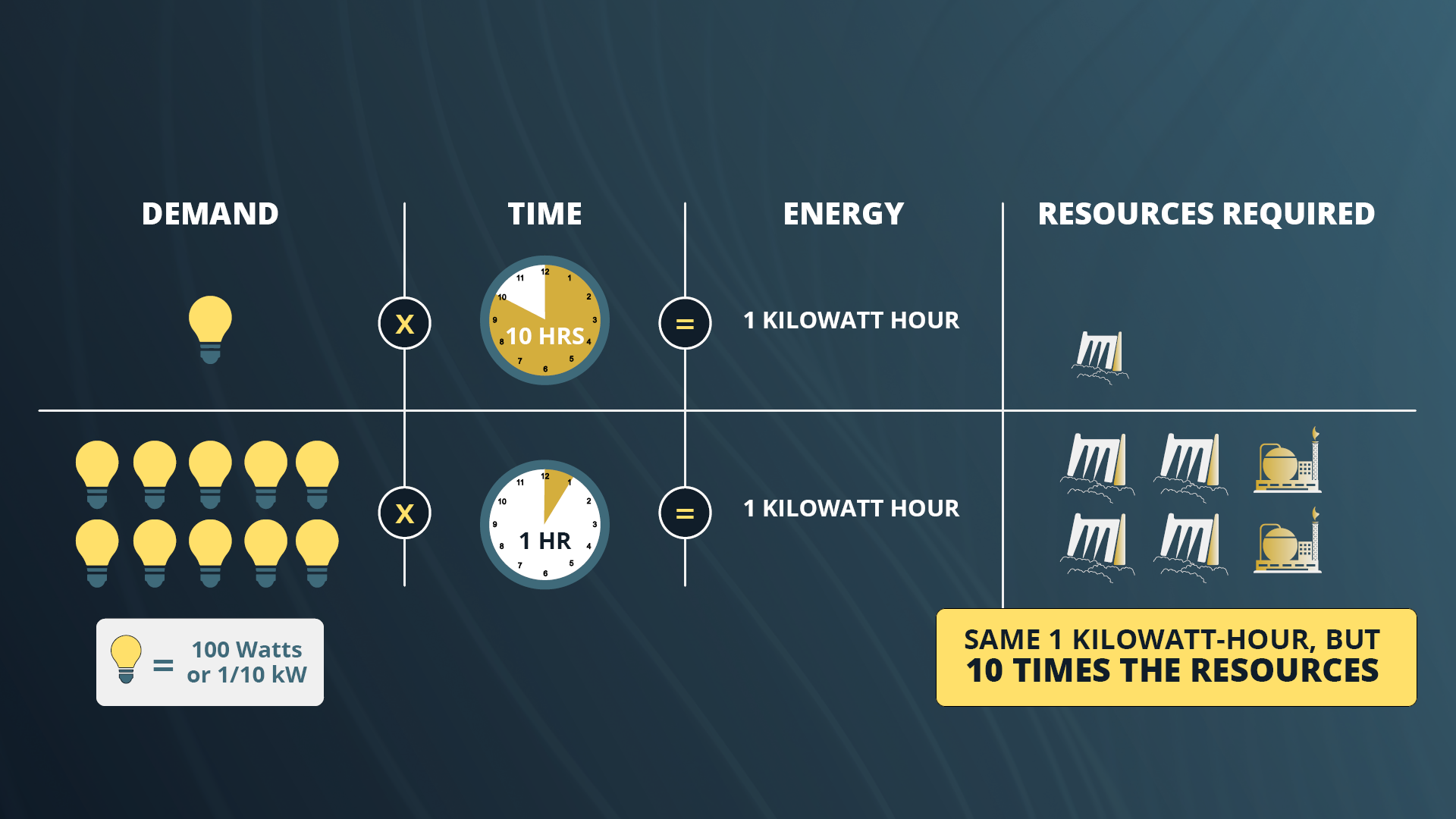
As more equipment and appliances in your home run simultaneously, your demand for power increases.
No, this was not a rate increase. This was a change in the rate structure and is designed to be revenue neutral which does not result in additional revenue for Benton PUD. See below for information on how you can lower your bill.
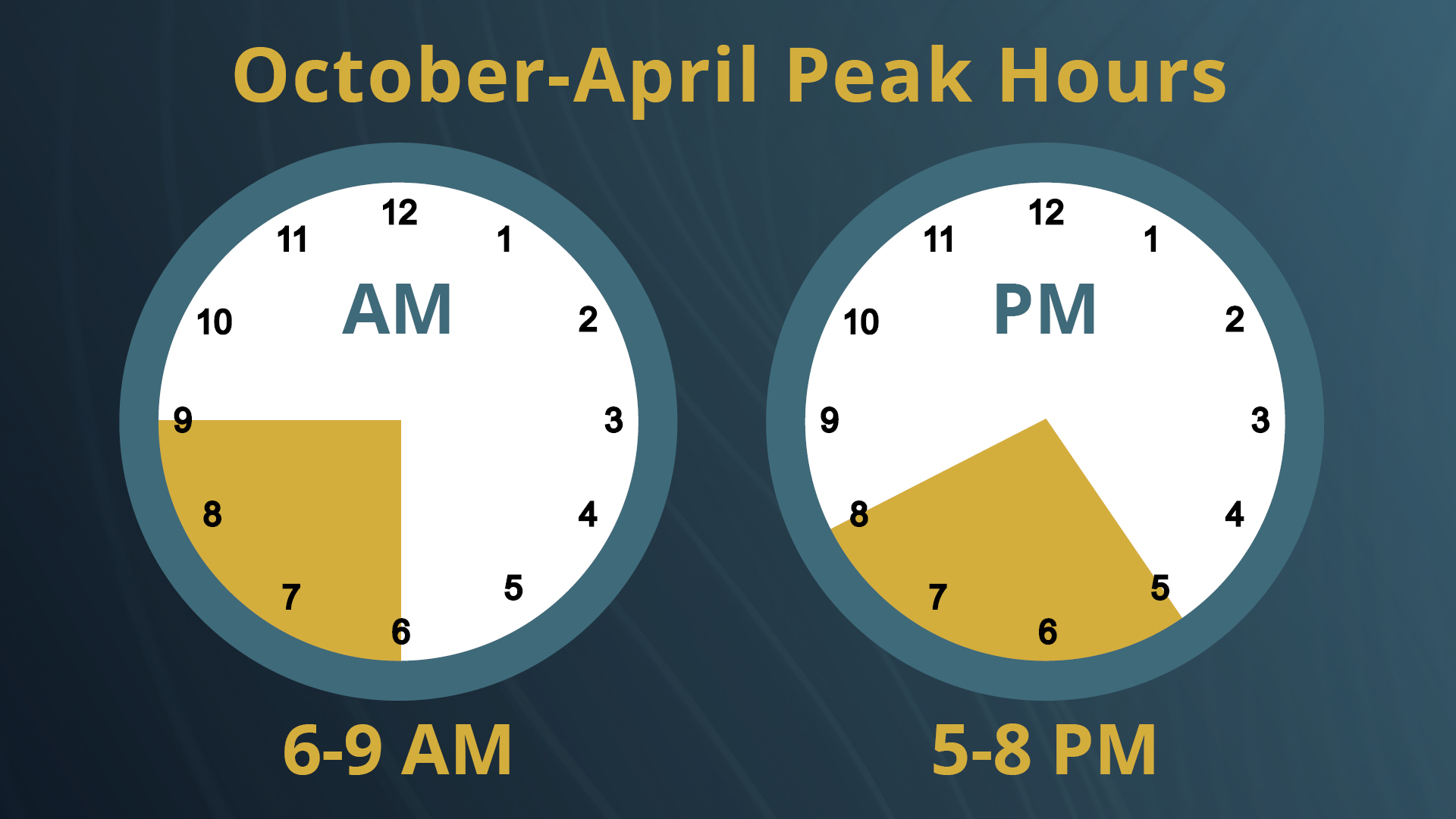
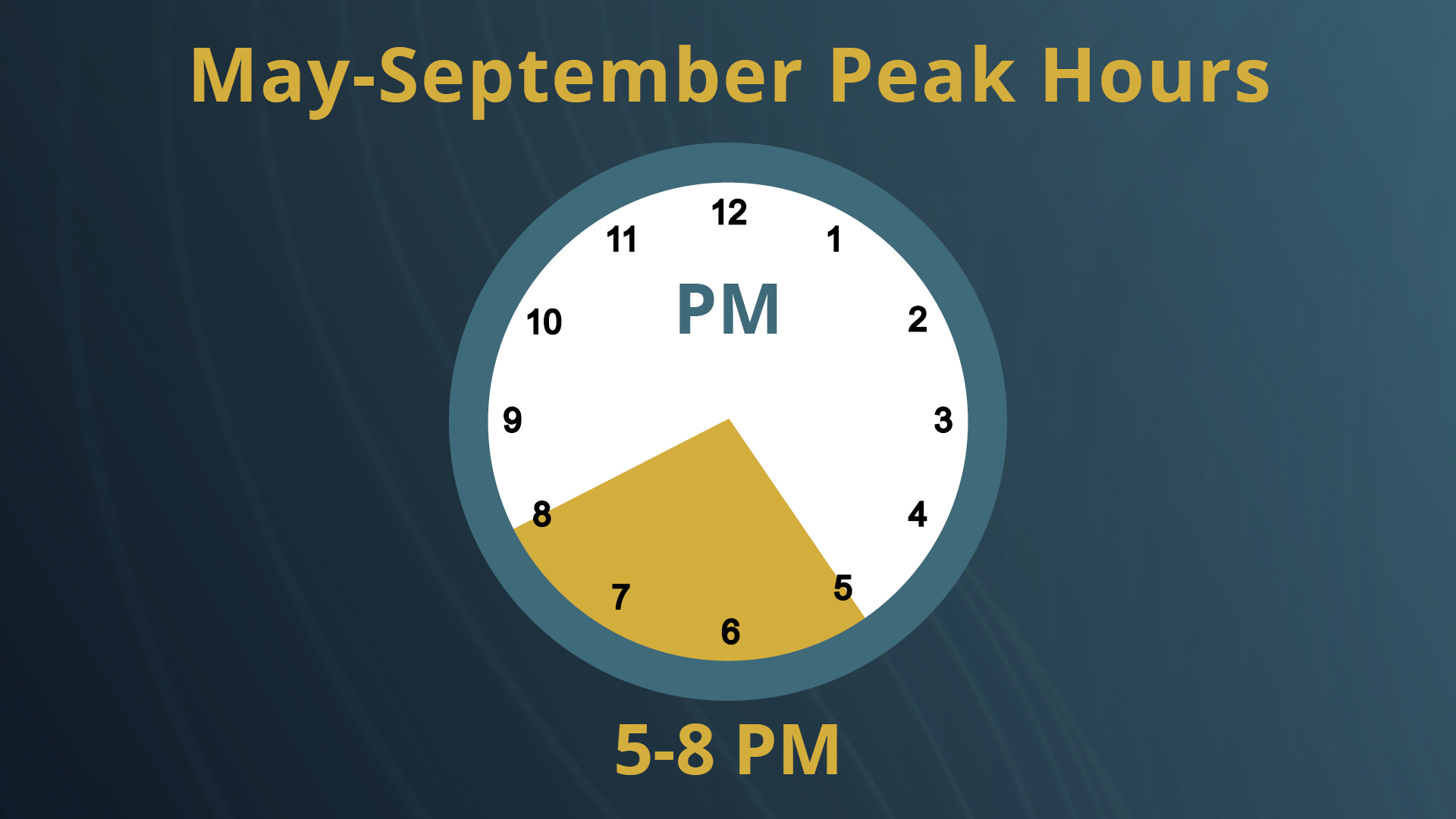
Between October 1 and April 30, peak hours occur Monday through Friday from 6 a.m. to 9 a.m. and 5p.m. to 8 p.m.
Between May 1 and September 30, peak hours occur Monday through Friday from 5 p.m. to 8 p.m.
All other hours are “off-peak” hours.
The demand charge is not based on any hours on weekends or certain federal holidays. In the event the holiday falls on a Sunday, all hours during the following Monday will be excluded from the peak hours. The certain Federal holidays include New Year’s Day, Memorial Day, Independence Day, Labor Day, Thanksgiving Day, and Christmas Day.
Benton PUD is not asking customers not to use electricity, change your lifestyles or turn your schedules upside down during peak hours. Instead, we are giving you more control on how to efficiently use power during the peak hours which can lead to saving money on electric bills by shifting energy use to off-peak hours.
The demand charge billing component was applied to your October 2023 usage, and was seen for the first time on your November 2023 bill.
Yes, residential customers with net metering will have a demand charge when the new rate structure goes into effect. It will be based on the highest one hour of usage from the utility during peak hours (the portion of customer usage in excess of what is being generated during that hour).
The demand charge has been in place with Benton PUD’s commercial, industrial, and large irrigation customers for most of our 77-year history, so it is not a new concept. While some costs of regional power grid generation and transmission have been included in longstanding demand charges, historically the biggest cost drivers were utility investments in equipment and wires required to avoid overloading local community electric delivery systems during high customer usage periods. Now aggressive clean energy laws are beginning to put a premium on the cost of supplying electricity during the hours of the day when customer demand is highest.
Benton PUD performs a Cost-of-Service Analysis study (COSA) annually that provides what level each rate component should be set at. A COSA is a standard tool that employs industry accepted methodologies to ensure fair allocation of costs and provides a basis for rate design. The COSA calculates what the daily system charge, demand charge, and energy rate for all rate classes should be, including residential. Historically, residential meters did not measure a demand read. As a result, the demand charge has been embedded in the energy charge, which is common in the utility industry. Through the installation of Advanced Metering Infrastructure (AMI), all meters now provide a demand reading which makes a demand charge for all metered services possible.
The results of the COSA study show 61% of the costs to serve residential customers are fixed for Benton PUD, and 39% are variable. However, historical residential rate design has 17% of revenue collected through a fixed charge (daily system charge) and 83% collected through a variable charge (energy rate). The graph below illustrates COSA results, the current rate design, historical rate design, as well as what comprises variable and fixed costs.
The COSA calculates what the rates should be to align how customers are billed with the nature of costs for the utility. For example, the energy rate should align with the cost of electricity received from BPA that is generated largely with hydro power as well as nuclear power. The daily system charge and demand charge are rates that align more closely with utility fixed costs such as peak capacity backup capabilities, transmission lines, substations, distribution lines and transformers, and customer support services. For residential customers, the COSA study shows the energy rate should be decreased, while a demand charge should be added, and the daily system charge (base charge) should be increased. A breakdown of the average monthly bill of $115 using COSA rates are as follows: variable costs 39% or about $45 (energy) and fixed costs 61% or about $70 (daily system charge $34 and demand charge $36) per month. For comparison purposes, the breakdown of the monthly average bill using current rates is as follows: variable costs 77% or about $89 (energy) and fixed costs 23% or about $26 (daily system charge $19 and demand charge $7) per month. Benton PUD is not proposing to change rates to be in full alignment with the COSA study.
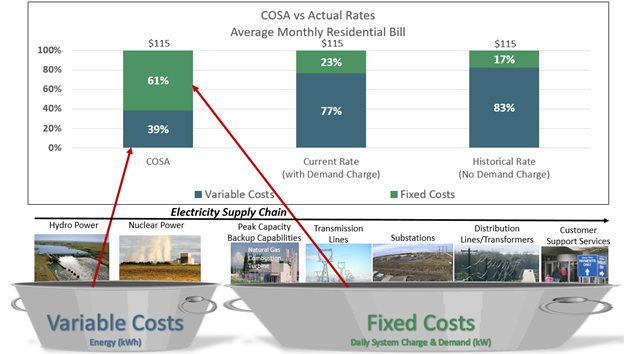
Most utilities have similar results with COSA studies, and many have opted to raise the base charge to a level of $30-$40 per month, which means every customer pays a higher monthly fixed charge regardless of how they use electricity. Instead of raising the base charge to the full COSA amount of $34, the implementation of $1 per KW demand charge begins to provide for the recovery of fixed costs, but in a manner that is proportional to a customer’s highest usage during peak hours. The initial demand rate will be set at $1.00/kW with a corresponding reduction to the energy rate and may be gradually further unbundled in future years.
We are implementing a change to our residential rate design to send a small price signal incentivizing customers to consider shifting some of their electricity use to hours other than those corresponding to periods of maximum power grid demand. In addition to ‘keeping the lights on,’ it is our job to be forward-thinking and to anticipate and plan for increases to our costs, which are your costs. With some of the most aggressive clean energy laws and regulations in the nation, including the Clean Energy Transformation Act (CETA) and Climate Commitment Act (CCA), Washington state’s unprecedented regulation of electric utilities is beginning to put a premium on the cost of supplying electricity during the hours of the day when customer demand is the highest. Think early morning and late evening during winter cold and early evening during summer heat.
We know energy policies can be confusing and politically polarizing, but the simple matter is that electricity is a just-in-time service where the unforgiving laws of power grid physics requires supply of electricity to precisely match demand on a minute-by-minute basis. While we are just beginning to experience increasing cost pressure during high customer demand periods, we anticipate this pressure will grow over time as utilities are forced to rapidly replace controllable, dependable, and affordable technologies with intermittent and variable wind and solar to satisfy CETA’s 100% non-greenhouse-gas emitting electricity requirements.
Benton PUD is not the first electric utility to implement a rate structure with a demand charge for residential customers. There are over 50 utilities in the nation that have implemented this type of rate structure with several in the Northwest and more are in the process of implementing.
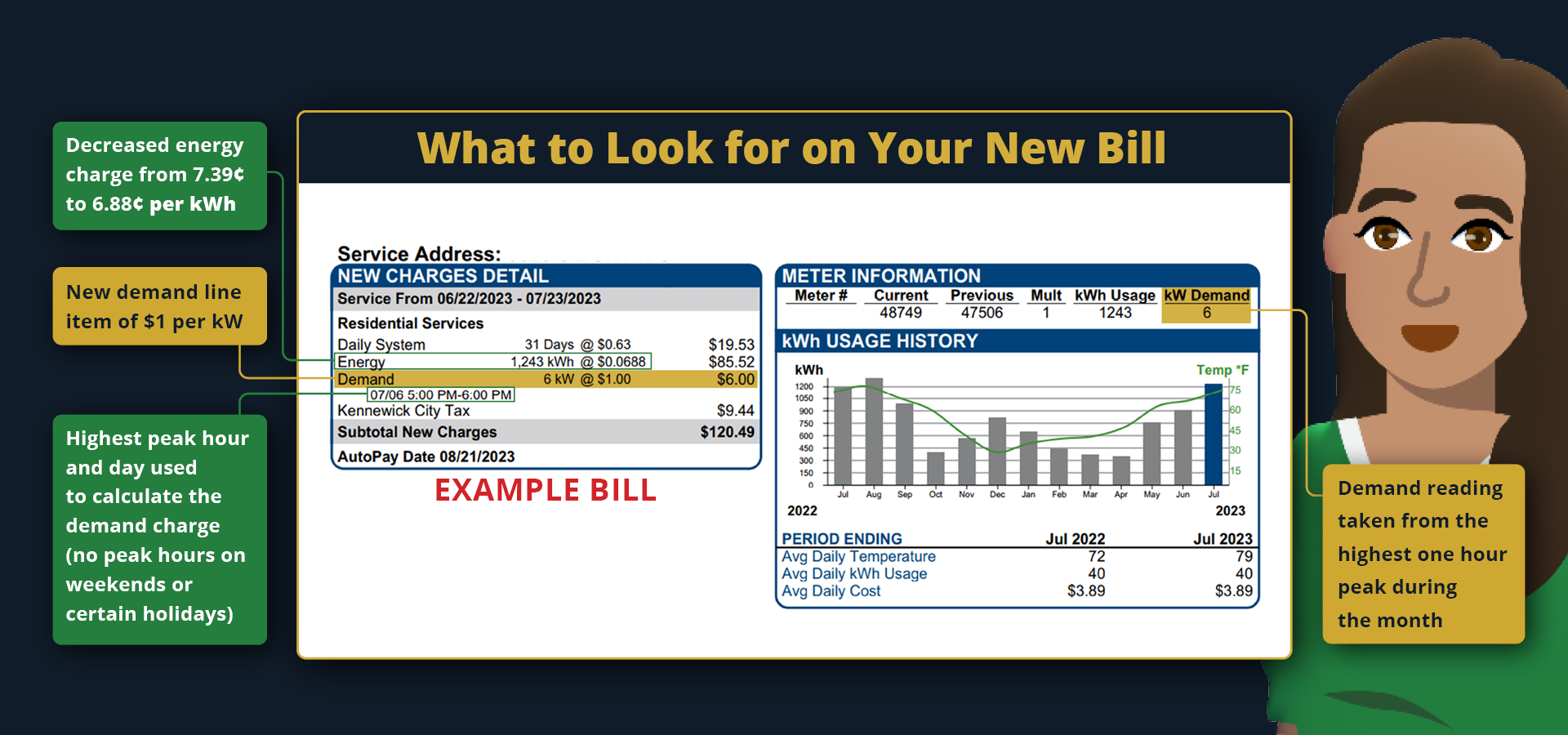
The impact of separating out the demand charge from the energy charge will vary from customer to customer. Some customers will see almost no changes, some will see an increase in their bill, while others will see a decrease. This will all depend on their demand and energy consumption, or in other words, how much energy they use each month, and their usage pattern will affect their bill amount. The impact can also fluctuate from month to month based on these factors. Most customer’s monthly bills will change by $5.00 or less on average, either as a reduction or an increase, depending on a customer’s usage during peak hours.
The demand charge is calculated based on the highest one-hour usage period during peak hours over the billing period. Spreading out activities that require a lot of energy throughout the peak hours instead of doing them all at once will help reduce your peak demand, which will lower your demand charge on your electric bill.
The following illustration shows how using all of these appliances at once creates a high demand. (It is for illustrative purposes only. Appliances such as a water heater, furnace or air conditioner do not typically run constantly for an entire hour, so the actual demand would be lower.)
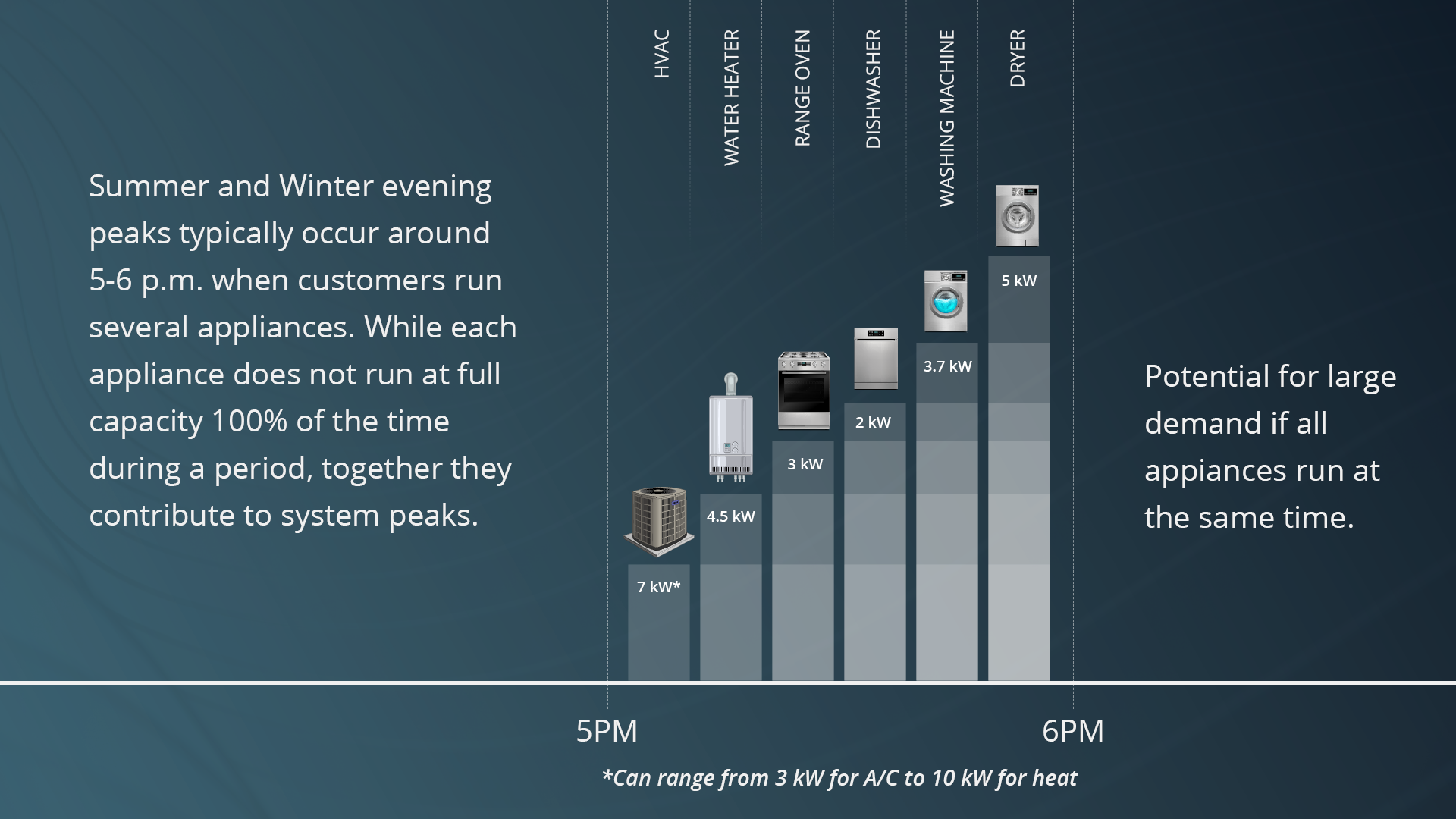
The new residential rate design provides an opportunity for customers to lower their electric bill by spreading out usage during peak periods or shifting to off-peak hours. For example, if you wanted to lower your bill you could operate your electric stove, oven, washing machine, clothes dryer, dishwasher, car charger and other large appliances at different time intervals during peak hours, and not all at once. You could start your washer or dryer after cooking and not to run your washer and dryer at the same time. You could also set your dishwasher, pool and spa pump, or electric vehicle charging to run after you go to bed.
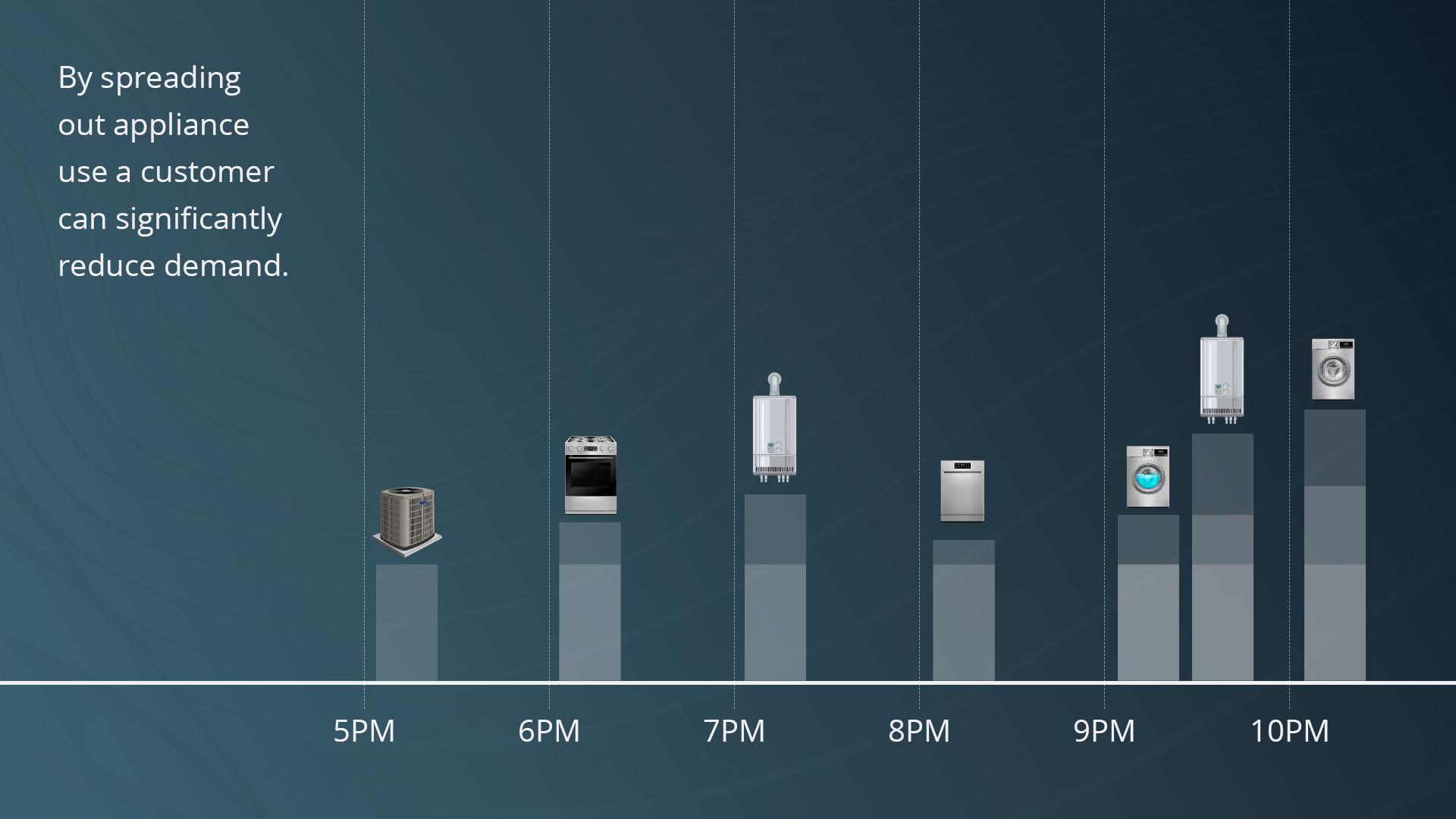
An EV charger creates a demand ranging from 1.5 kW for a Level 1 charger to 7.5 kW or more for a level 2 charger which could significantly increase a customer’s demand charge. Most EVs and home charging stations allow you to program when you want to charge them. By setting the charging time to off-peak hours (e.g., after 8:00 PM on weekdays), this additional demand won’t be included in a customer’s demand charge. It’s the same concept as moving the use of major appliances to off-peak hours to lower the demand charge.
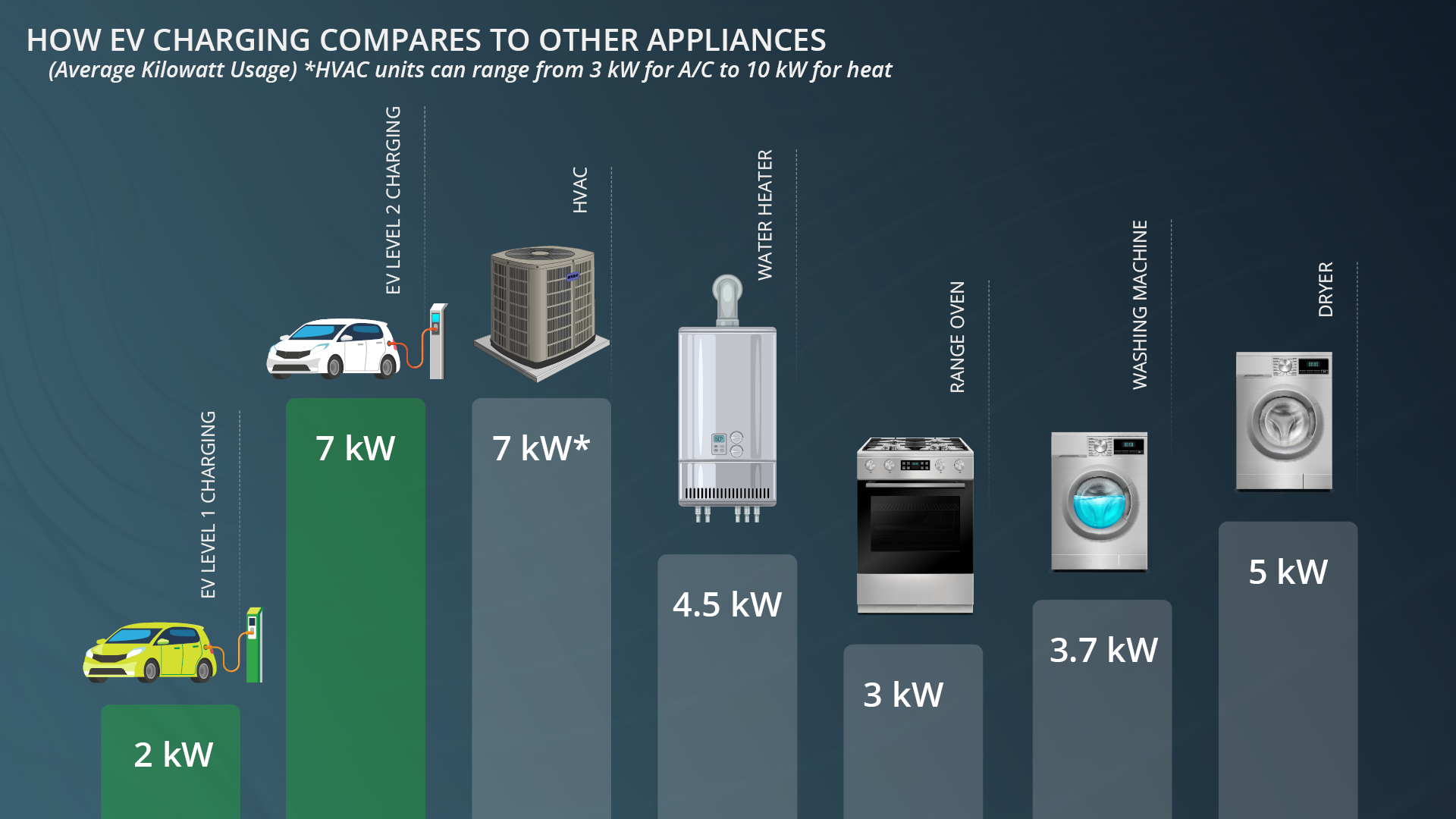
SmartHub is an online portal that allows you to manage your account, make payments, track usage, sign up for alerts and notifications, and so much more! If you don’t have SmartHub yet, make sure to sign-up now. Login to SmartHub to view your usage throughout the billing period. The Demand charge will be based on the highest one-hour usage during peak hours during the billing period. By utilizing your usage history, you will be able to identify trends of when you set your peak demand. This will allow you to make future decisions to change how you consume electricity if you want to lower future bills.
In the event you see a demand that is different than what you are billed for it is either not within the peak hours or it is an estimated value. Estimated values are rare as our meters transmit usage information that is displayed in SmartHub with a 99.9% success rate. SmartHub may use an estimation for graphical purposes in the event a meter hasn’t reported data for particular one-hour intervals. In order to not overcharge a customer estimated data will not be used for billing.
There are many steps customers can take to lower their monthly energy costs. With the helpful tools and resources that Benton PUD offers, using energy wisely is easier than you think. You can find Energy Saving Tips for your Home, Do-It-Yourself Energy Audit, and High Bill Inquiry information on our website.
For Pay As You Go participants, the demand charge is calculated by using the highest eligible demand reading from the past 30 days and prorating that amount to charge daily instead of monthly.
For example, if the highest demand reading during peak hours from the past 30 days is 6 kW, then we divide the $6.00 charge ($1 per kW) by 30 (days in the month) to get a daily demand billing of $0.20 added to the daily usage charges.
Each charge on the electric bill covers different costs associated with providing electrical service to the customer.
Energy Charge – A variable charge to cover the cost of energy used in the billing period, measured in kilowatt hours (kWh). It is intended to cover the costs of purchasing power from our wholesale power and transmission provider.
Daily System Charge – A flat fee to cover the fixed costs of operating the utility. Examples include the office building, billing, metering systems and equipment, office personnel, taxes, and debt service.
Demand Charge – A variable charge based on the highest rate of electric use during the highest one hour usage period during peak hours over the billing period, measured in kilowatts (kW). The demand charge covers the costs of having adequate power supply capacity as well as utility investments in equipment and wires required to avoid overloading local community electric delivery systems during high customer usage periods.
.png?lang=en-US)
